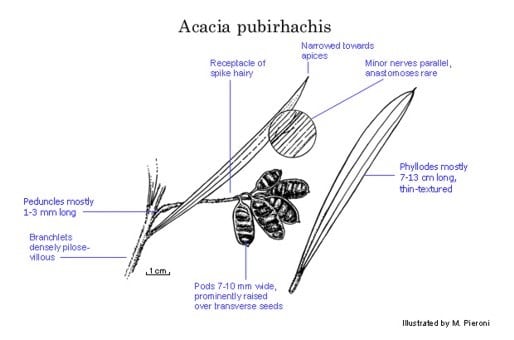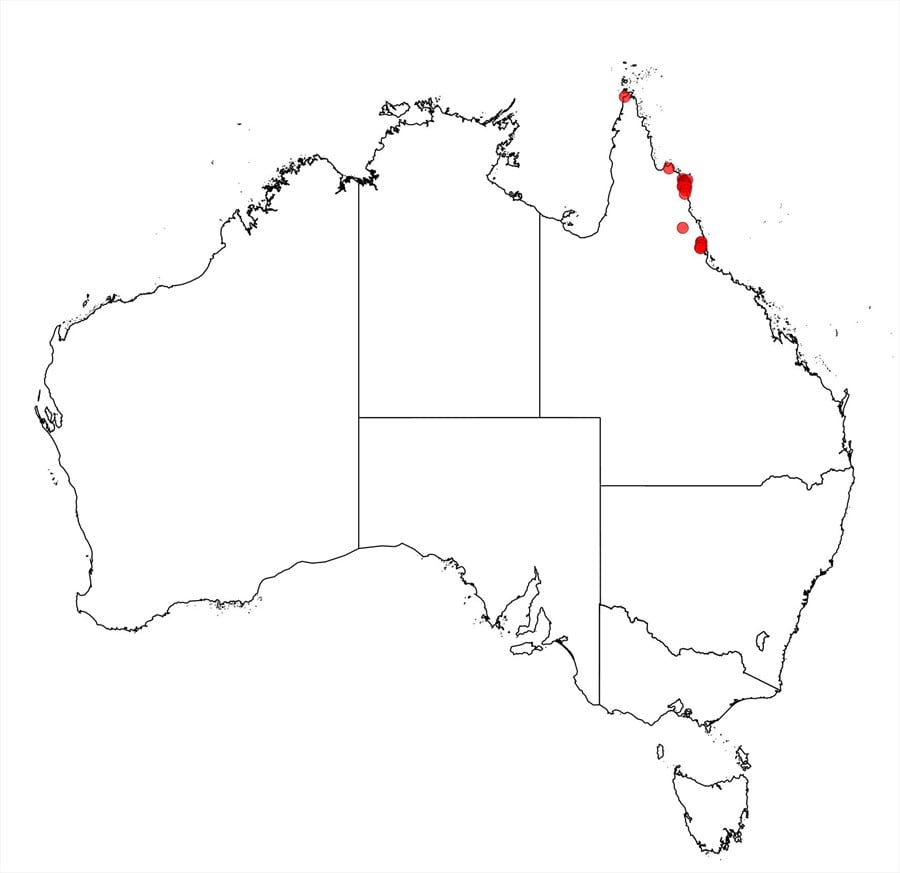Acacia pubirhachis Pedley
WATTLE
Acacias of Australia
Family
Fabaceae
Distribution
Occurs in coastal north-eastern Qld near the mouth of the Tully R. and just N of Cooktown. Also occurs in the Western Province of Papua New Guinea.
Description
Shrub or tree, 2–8 (–10) m high. Bark rough, fissured and fibrous, dark reddish brown. Branchlets rather angled, substout, sometimes blackish, densely villous-pubescent. Phyllodes narrowly elliptic to almost linear, occasionally oblanceolate, straight to shallowly incurved, (5.5–) 7–13 cm long, 4–10 (–12) mm wide, acute to obtuse with a distinct mucro 1–2 mm long (sometimes wanting on oldest phyllodes), densely appressed silky when young but later glabrous or subglabrous; multistriate by parallel, non-anastomosing nerves (4–6 per mm) with 2 subcentral nerves (of unequal prominence) more pronounced than the rest; gland 0–2 mm above pulvinus, second gland normally present at base of apical mucro. Inflorescences simple; spikes 2.5–6 cm long, golden; receptacle densely tomentulose, moderately dense; peduncles densely tomentulose, 1–3 (–4) mm long. Flowers 5-merous; calyx gamosepalous, dissected to 1/3, hairy along margins; corolla glabrous. Pods oblong to narrowly oblong, straight-sided, 2–5 cm long, 7–10 mm wide, firmly chartaceous to thinly coriaceous, dark coloured, glabrous when mature; margins prominent, pale coloured. Seeds transversely oblique, 5–5.5 mm long, brownish black; areole brownish black; arillate.
Phenology
Flowers July–Sept.
Habitat
In Papua New Guinea it is uncommon and grows in heavy clay soils in seasonally waterlogged swamps. Grows in white sand, usually in seasonally waterlogged dune swales or Melaleuca swamps, and occasionally an emergent in heath.
Specimens
Qld: c. 38 km NNW of Cooktown, J.Clarkson 3306 (BRI, NSW); 6.4 km beyond Hopeale Mission, P.Hind 1055 & C.K.Ingram (BRI, CANB, K, MEL, NSW, UC, US); 2 km from beach towards Starcke Stn, P.Hind 2300 (CANB, NSW).
Notes
The features that distinguish Acacia pubirhachis from A. multistipulosa and A. conspersa are described by M.D.Tindale et al., Austral. Syst. Bot. 9: 860 (1996).
FOA Reference
Data derived from Flora of Australia Volumes 11A (2001), 11B (2001) and 12 (1998), products of ABRS, ©Commonwealth of Australia
Author
Dr M.D.Tindale and Dr P.G.Kodela with the assistance of M.Bedward, S.J.Davies, C.Herscovitch, D.A.Keith and/or D.A.Morrison
Revised by B.R.Maslin
This identification key and fact sheets are available as a mobile application:
URL: https://apps.lucidcentral.org/wattle/
© Copyright 2018. All rights reserved.







